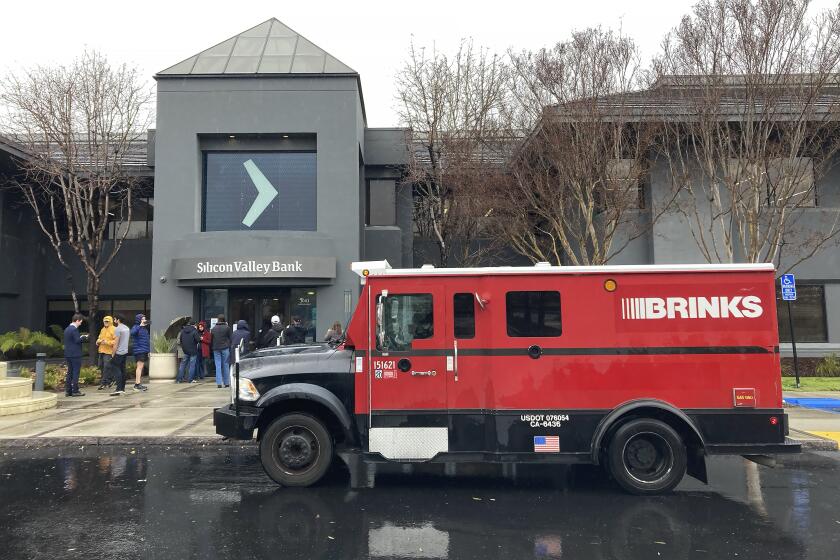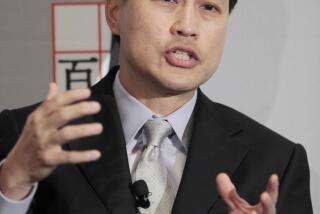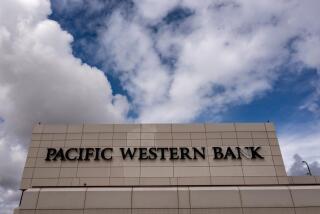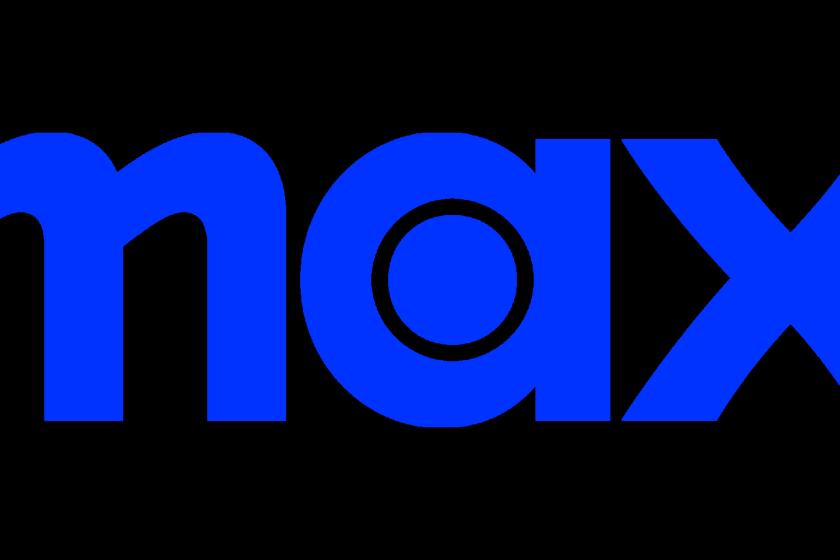First Republic gets $30 billion in rescue funds from other banks
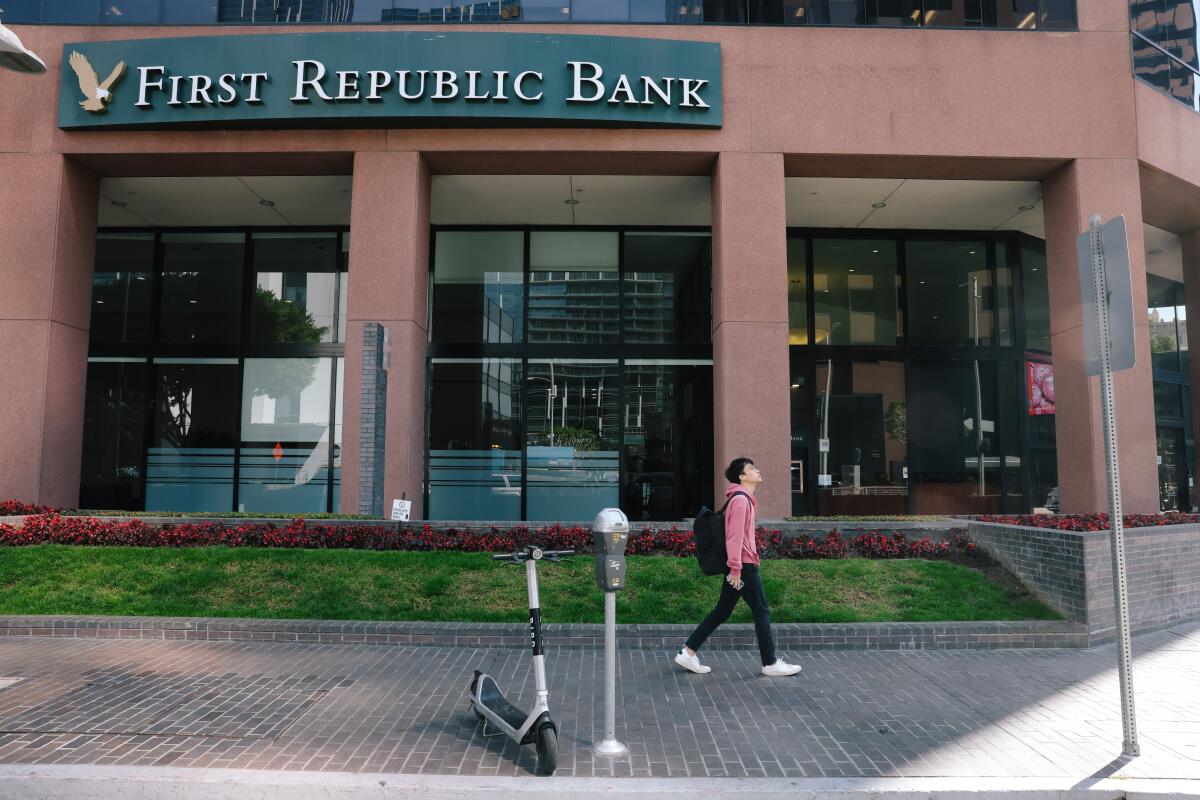
- Share via
The nation’s biggest banks agreed to deposit $30 billion with First Republic Bank in an effort to stem the turmoil that’s sent depositors fleeing from regional banks and shaken the country’s financial system.
JPMorgan Chase, Bank of America, Citigroup and Wells Fargo will each contribute $5 billion of uninsured deposits, while Goldman Sachs Group and Morgan Stanley will each kick in $2.5 billion, according to a statement Thursday. Other banks will deposit smaller amounts.
“This action by America’s largest banks reflects their confidence in First Republic and in banks of all sizes,” the banks said in the statement. The consortium cited the outflows of uninsured deposits at a small number of banks after the collapse of Silicon Valley Bank and Signature Bank.
The three-paragraph statement gave no terms for the commitments. The banks’ initial commitments will be for at least 120 days, though they could be extended beyond that, according to people familiar with the matter. A representative for First Republic didn’t immediately respond to a request for comment.
First Republic has been exploring strategic options including a possible sale, Bloomberg News reported late Wednesday. The San Francisco lender’s shares have plummeted in the aftermath of regulators’ seizure of fellow regional lenders Silicon Valley Bank and Signature Bank over the last week.
Financial turmoil has some people wondering if a systemic problem is putting all banks in peril, as in the Great Recession. Experts say that isn’t the case.
“This show of support by a group of large banks is most welcome and demonstrates the resilience of the banking system,” U.S. Treasury Secretary Janet L. Yellen, Federal Reserve Board Chair Jerome H. Powell, Federal Deposit Insurance Corp. Chairman Martin Gruenberg and acting Comptroller of the Currency Michael Hsu said in a joint statement.
Also contributing are PNC Financial Services, Bank of New York Mellon, Truist Financial Corp., U.S. Bancorp and State Street Corp., which will each deposit $1 billion.
The deal began to take shape Tuesday and came together in about two days, with the idea of bringing the banks on board broached during a call that included Yellen, Powell and Gruenberg, as well as JPMorgan Chief Executive Jamie Dimon, according to people familiar with the matter.
Yellen and Dimon agreed the idea had merit, with Dimon taking the lead to contact other bank leaders and Yellen making calls too, said the people, who asked not to be identified discussing the private talks.
Another call Thursday morning among regulators and CEOs helped finalize the plan. The deal includes deposits with an initial term of 120 days at market rates, First Republic said, and they could remain in place even longer, people familiar with the terms said.
In some ways, the rescue resembles the 1998 plan devised to bail out Long Term Capital Management without using public money, after the hedge fund made a set of disastrous wrong-way bets. Back then, the Fed convened a meeting of Wall Street executives from Merrill Lynch, Goldman Sachs and about a dozen other companies. They agreed to pump $3.65 billion into the fund to keep it afloat and avert a collapse in financial markets.
As with Long Term Capital Management, the banks saw saving First Republic as ultimately in their best interests, rather than risk a widening panic that might engulf more of them, one of the people said. Unlike Long Term Capital Management, the First Republic rescue isn’t a wind-down, but sets up the bank to have a future, which could still include shopping around for a buyer, the people said.
The joint effort “is a powerful step to bolster liquidity and reflects our confidence in the critical role of regional banks in our economy and across the communities we serve,” Truist Chief Executive Bill Rogers said in an emailed statement.
Shares of First Republic swung wildly Thursday, plunging as much as 36% early in the day, then surging as much as 28% midday after details of the emerging plan were first reported. They closed up 10%, but slipped in extended New York trading after the bank announced it was suspending its dividend.
First Republic, which specializes in private banking and has built up a wealth-management franchise with some $271 billion in assets, has made an effort to differentiate itself from SVB Financial Group’s Silicon Valley Bank. Unlike SVB, which counted startups and venture firms among its biggest clients, First Republic said that no sector represents more than 9% of total business deposits.
Silicon Valley Bank collapsed into FDIC receivership Friday after its customer base of tech startups grew concerned and pulled deposits.
First Republic Chairman Jim Herbert and CEO Mike Roffler said in a statement that the banks’ “collective support strengthens our liquidity position, reflects the ongoing quality of our business and is a vote of confidence for First Republic and the entire U.S. banking system.”
As of Wednesday, First Republic had a cash position of about $34 billion, not including the deposits from the banks. Since the close of business March 9, First Republic has increased short-term borrowings from the Federal Home Loan Bank by $10 billion at a rate of 5.09%, the company said.
First Republic said it’s “focused on reducing its borrowings and evaluating the composition and size of its balance sheet,” and will suspend its stock dividend while it recovers.
First Republic has been working with JPMorgan as it tackles its challenges. On Sunday, the same day Signature Bank was taken over by regulators, First Republic said it “further enhanced and diversified its financial position” by securing additional liquidity from the Federal Reserve and JPMorgan.
“The effort by the federal government to bring together the banking sector, including U.S. Bank, speaks to the strength of the overall financial system,” said a spokesman for the Minneapolis-based lender.
Bloomberg writers Katherine Doherty, Allyson Versprille, Jenny Surane, Saleha Mohsin and Annmarie Hordern contributed to this report.
More to Read
Inside the business of entertainment
The Wide Shot brings you news, analysis and insights on everything from streaming wars to production — and what it all means for the future.
You may occasionally receive promotional content from the Los Angeles Times.
